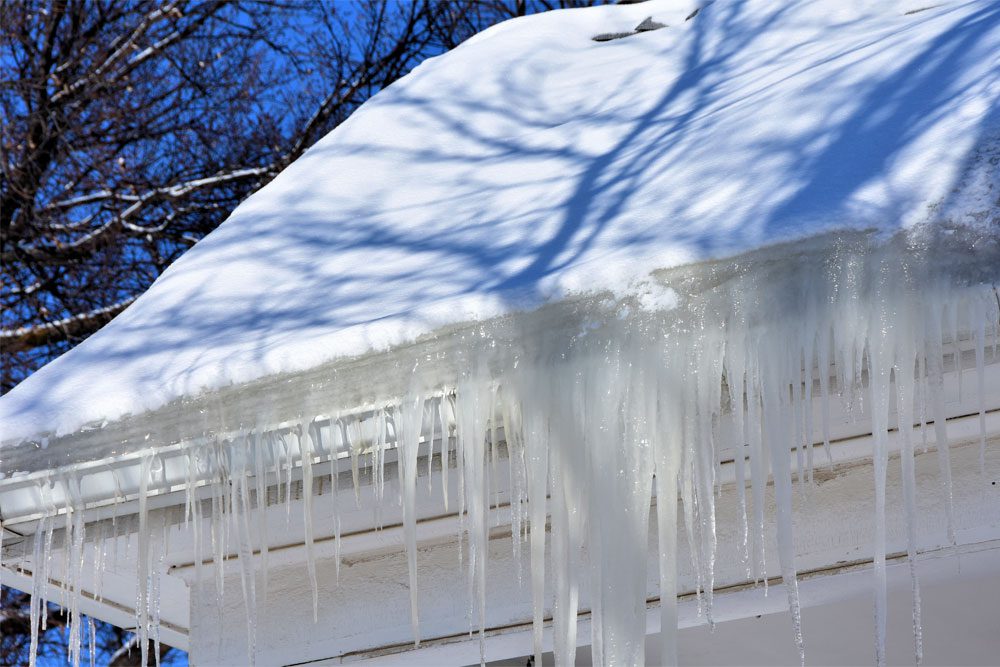Should you be worried about an ice dam forming on your roof and gutters when colder weather arrives? If past winters are any indication, the answer is yes. New England has traditionally been a hotbed for these seasonal hassles, especially following a heavy snowfall.
Even if we happen to have an unusually warm winter with little to no snow accumulation, your home will not necessarily be safe from this icy threat. A large rain event combined with freezing temperatures can lead to ice damming just as quickly as a big storm that dumps several feet of snow.
The main reason most homeowners dread ice dams is the vast amount of damage they can do. Whether it grows to be a monstrous structure weighing in at over 1,000 lbs. or remains relatively small and just a few inches around, an ice dam has the potential to ruin your roof, gutters, ceilings, walls, insulation, floors, and more.
The Gilbert Insurance team knows our clients and neighbors have lots of questions about ice dams and how to avoid them. We’ve gathered some interesting facts and important prevention tips to help you better understand this perennial property threat and how you may be able to safeguard your home from it.
The name says it all, actually—an ice dam is literally a dam-like buildup of ice. The damming often happens in a home’s gutters, but even houses that don’t have gutters are at risk as an ice dam can form on the cold edge of a roof or higher up in certain circumstances.
As mentioned previously, it doesn’t take an epic snowstorm for an ice dam to form. In fact, there doesn’t need to be much snowfall at all for the ice damming process to begin. The biggest factor in ice dam formation is when the temperature fluctuates from freezing to warm, which is a common occurrence during a New England winter!
Most of the time, though, the ice dam process happens like this:
- After a snowfall, heat from the sun or from inside your home warms your roof.
- The snow and ice on your roof melts.
- Water flow from this melted snow and ice refreezes when it reaches your colder roof edge or gutters, beginning the ice dam formation.
- If the ice dam goes untreated, there is nowhere for the water flow from melting snow and ice to go. Instead of draining away from your home, this water may back up under your roof and leak inside.
Underlying this ice dam formation process are three main causes—the weather, household heat escaping from your attic that warms your roof, and uneven roof temperatures. By addressing these root causes, you may be able to prevent ice dams from forming. If you’re ready to get started on putting a stop to ice dams on your property, feel free to jump right to some prevention tips.
What does an ice dam look like?
Often, ice dams start off as harmless-looking icicles, and sometimes, in the early formation stages, they aren’t visible at all. (The fact that an ice dam may go unnoticed by a homeowner for a while is one of the main reasons it can end up causing so much damage.) More obvious signs of an ice dam include a big block of ice in your gutters, a thick layer of ice on your roof, or giant icicles hanging from the edge of your roof or gutters.
There may also be ice damming warning signals coming from inside your home. The following are some things to keep an eye out for as they may be signs that you have an ice dam or that one is in the process of forming:
- Icicles on your roof and around the exterior of your house don’t necessarily mean an ice dam has formed, but they are often the precursor to one.
- Ice buildup or water dripping down exterior walls of your home, beneath siding, behind the soffit, or in any other odd places may indicate an ice dam.
- Gutters that aren’t draining may mean an ice dam has formed and is causing water to back up under your roof.
- Water stains or moisture inside your attic or along your ceilings or walls or ice or water inside or around your window frames should be investigated right away because it could mean an ice dam has formed.
How do you prevent an ice dam from forming?
To stop an ice dam from forming in the first place, homeowners need to understand the three root causes of these winter menaces and the steps they can take when these troublesome conditions arise.
- Snow and ice accumulation. There’s not much anyone can do about Mother Nature and her plans for us this winter. However, there are a few things you can do to try to keep your roof clear of snow and ice. For example, safely using a roof rake, installing ice-melting roof cables, or adding an aluminum ice belt to your roof’s edge may help get rid of snow and ice before they have a chance to build up.
- Home heat escaping. Having a properly insulated home is one of the keys to keeping warm air inside where it belongs. While most houses have some attic insulation, many may be under-insulated, according to the North American Insulation Manufacturers Association (NAIMA). In addition, your home’s attic insulation may not be as effective as it was when originally installed if it has since settled, been compressed, or gotten wet. It’s important to have a professional assess how well your house is insulated and upgrade or add insulation if needed.
- Uneven roof temperature. Even if your attic is well insulated and all holes, air leaks, and drafts in the attic have been sealed off, some heat may still find its way to parts of your roof, warming it unevenly. In addition, the sun’s rays can also create a situation where certain areas of your roof become warmer than others. To promote a consistently cool roof and reduce the likelihood of an ice dam forming, it’s essential to circulate cold air under the entire roof. The easiest way to do this is by improving attic ventilation with the appropriate intake vents, like a soffit vent, and exhaust vents, like a ridge vent.
How do you remove an ice dam?
While you may have the urge to simply follow the instructions that pop up when you Google “how to remove an ice dam” or to take matters into your own hands after consulting a YouTube video showing how to get rid of this structure, the Gilbert team recommends you don’t try to perform this challenging task yourself. If the ice dam is not removed properly, you could cause substantial damage to your home and even injure yourself in the process. It’s best to leave ice dam removal to a licensed, insured professional who has specialized equipment and can get the job done with far less risk of harming your roof or other parts of your home.
How much does ice dam removal cost?
The cost to remove an ice dam can vary greatly because it depends on several factors, including the removal method that is used, the size of the home and the square footage of its roof, and the severity of the ice dam and how difficult it is to access. While homeowners typically must cover all ice dam removal costs themselves, some insurance companies may help pay for the removal of a portion of an ice dam that is directly causing a home leak. In addition, many insurance companies may cover damages an ice dam does to the structure of your home and help you pay for the additional expenses you incur if you have to temporarily relocate while the ice dam and the damage it caused is being taken care of. Sometimes your homeowners policy coverage may even apply to contents inside your home that have been ruined as a result of the ice dam. However, it is important to double-check the extent of your coverage with your insurance professional.
If you do uncover damages, whether inside or outside your home, that are a direct result of an ice dam or another similar winter weather threat, please reach out to your Gilbert Insurance professional. They will be able to guide and support you through the home insurance claims process.
Of course, you don’t have to wait for an ice dam or other winter nuisance to create problems on your property in order to enlist our assistance. Feel free to reach out to one of our knowledgeable professionals today for a review of your home, car, business, and other insurance policies so you can gain a thorough understanding of what may or may not be covered if one of these events occurs, as well as advice on how to affordably broaden your protection if needed.

